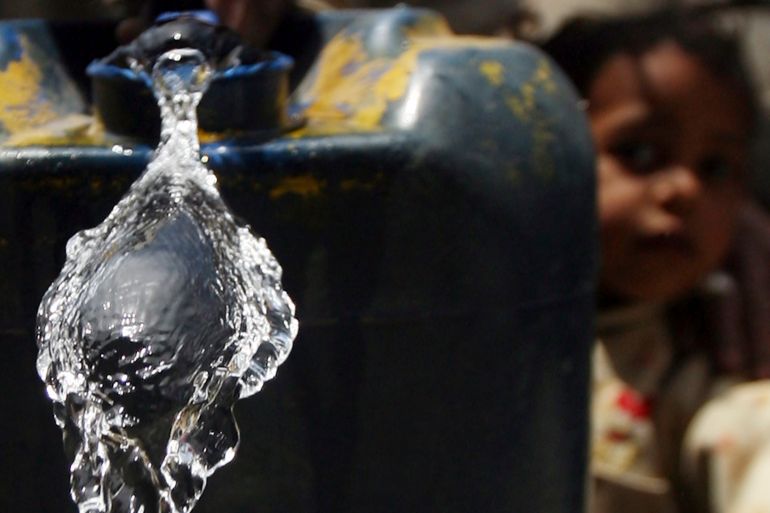Tanzania’s Dar-es-Salaam hit by water shortages as rivers dry up
Climate change is only part of the reason behind the water shortage in Tanzania’s largest city, home to more than six million people.

Fridoline Mtunguja, 56, has never been as busy during the 19 years he has delivered water across Dar-es-Salaam as he has been this past month.
“I am working morning until night,” said Mtunguja. “I have not seen a problem like this for a long time and we don’t know how long it will continue.”
Keep reading
list of 3 itemsWater scarcity reaches crisis point in northern Syria
Hundreds protest in Jordan against water-energy deal with Israel
At the start of November, authorities in Dar-es-Salaam declared a water shortage and began rationing throughout Tanzania’s largest city, home to more than six million people.
While mid-October spells the start of the short rains, the country has instead experienced record high temperatures and little rainfall – associated with climate change. In Dar-es-Salaam, temperatures reached 33.8 degrees Celsius (92.84 degrees Fahrenheit), an increase of 2.2C (4F) compared with the average temperature in November.
As a result, the city’s main source of water, the Ruvu River, has reached dangerously low levels – leaving Dar-es-Salaam with a deficit of nearly 100 million litres (26.5 million gallons) of water.
While the Dar-es-Salaam Water and Sewerage Authority (DAWASA) initially estimated the rationing would last for a day, one month later many parts of the city are still without a regular water supply. The Law and Human Rights Centre (LHRC) in Tanzania has called on the government to make immediate efforts to address the crisis.
But experts say climate change is only part of the reason behind the shortage. Commercial activity – legal and illegal – along the Ruvu River has contributed significantly to lower water levels. Earlier in September, the Wami/Ruvu Basin authority restricted water-based commercial activities.
“We are feeling a crisis because the water levels are not able to meet the demand,” Elibariki Mmasi, the acting director of the Wami/Ruvu Basin Water Board (WRBWB), told Al Jazeera. “We have recently given out fines and arrested many people for abstracting water without a permit.”
As an immediate step, the president ordered tightened security around the water sources. While this has increased levels, it has not been enough to make up the deficit.
“DAWASA has one of the highest rates of water loss,” said Herbert Kashililah, chair of the Tanzania Water and Sanitation Network. “Almost half of the water is lost through faulty equipment but also from illegal connections.”
The impact of the crisis – a combination of climate change, over-abstraction and water loss – has been severe. At the national hospital, patients have been unable to receive dialysis treatment, according to doctors.
“Dialysis requires a lot of water. One patient can use 120 litres in four hours,” said Dr Engina Makwabe, a medical specialist based in Dar-es-Salaam. “Over 100 patients had to be transferred. The water shortage made it difficult to maintain hygiene standards. Toilets couldn’t be flushed and handwashing could not be practised. It is possible the infection rate went up.”
Across Dar-es-Salaam, city dwellers are now relying on a local network of boreholes and wells. For those without a source of water nearby, they are left with no option but to buy from private vendors. With the demand high and supply low, prices have soared. Vendors are selling water for more than double the price.
Some of the biggest hotels are also feeling the effects, warning guests that water may run out before midnight.
There are also concerns about the safety of the water being sold.
Upendo Chitinka, a resident of Dar-es-Salaam who recently got 2,000 litres (528.5 gallons) of water delivered to her home in Mikocheni, believes the water has come from an unsafe source.
“The water smelt and the colour was off,” said Chitinka. “There are rumours that some vendors are taking water from the ocean and mixing it to supply to houses.”
Reliant on hydropower, the city’s water challenges have also resulted in power rationing. The Tanzania Electric Supply Company Limited (TANESCO) reported that water levels in several dams had reduced, causing a 21 percent drop in daily power production. Representatives across the private sector lamented the power cuts, saying it has increased production costs.
Many are hoping the end is now in sight. At the end of November, the city received its first rains of the season, which the Tanzania Meteorological Agency (TMA) has forecast to continue. But with climate change causing more frequent heatwaves, the city needs a long-term solution to its water woes, experts said.
“For now, we have stopped all activities on the river except domestic use,” said Mmasi. “But in the long term, we will need to construct more boreholes and a dam so that we can meet future demands.”